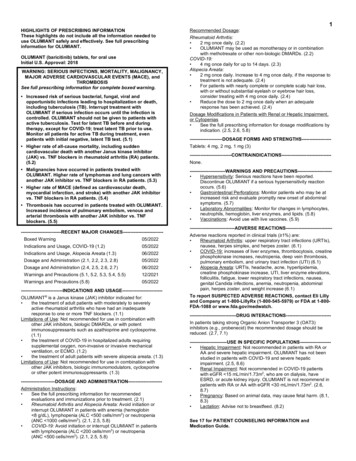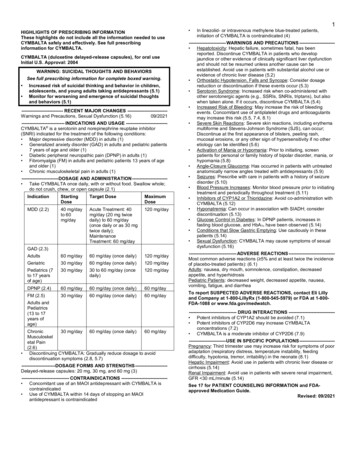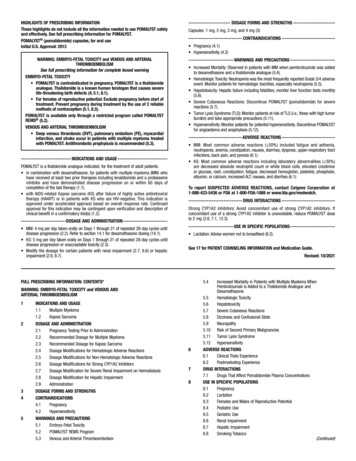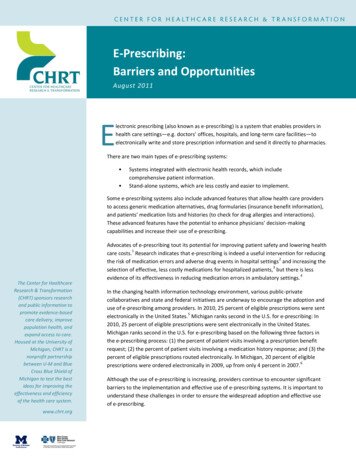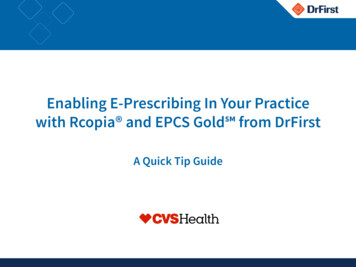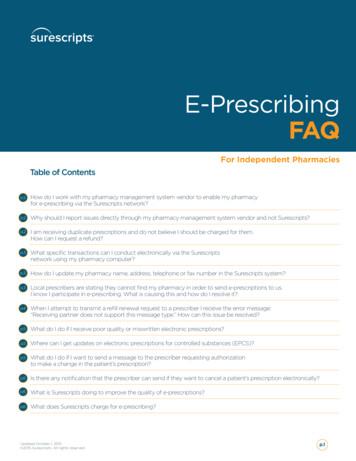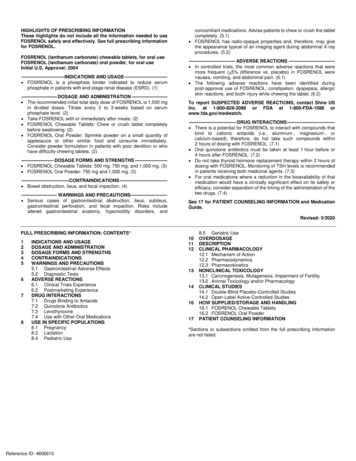
Transcription
HIGHLIGHTS OF PRESCRIBING INFORMATIONThese highlights do not include all the information needed to useFOSRENOL safely and effectively. See full prescribing informationfor FOSRENOL.FOSRENOL (lanthanum carbonate) chewable tablets, for oral useFOSRENOL (lanthanum carbonate) oral powder, for oral useInitial U.S. Approval: 2004----------------------------INDICATIONS AND USAGE--------------------------- FOSRENOL is a phosphate binder indicated to reduce serumphosphate in patients with end-stage renal disease (ESRD). (1)----------------------- DOSAGE AND ADMINISTRATION ---------------------- The recommended initial total daily dose of FOSRENOL is 1,500 mgin divided doses. Titrate every 2 to 3 weeks based on serumphosphate level. (2) Take FOSRENOL with or immediately after meals. (2) FOSRENOL Chewable Tablets: Chew or crush tablet completelybefore swallowing. (2) FOSRENOL Oral Powder: Sprinkle powder on a small quantity ofapplesauce or other similar food and consume immediately.Consider powder formulation in patients with poor dentition or whohave difficulty chewing tablets. (2)--------------------- DOSAGE FORMS AND STRENGTHS -------------------- FOSRENOL Chewable Tablets: 500 mg, 750 mg, and 1,000 mg. (3) FOSRENOL Oral Powder: 750 mg and 1,000 mg. S ------------------------------ Bowel obstruction, ileus, and fecal impaction. (4)----------------------- WARNINGS AND PRECAUTIONS----------------------- Serious cases of gastrointestinal obstruction, ileus, subileus,gastrointestinal perforation, and fecal impaction. Risks includealtered gastrointestinal anatomy, hypomotility disorders, andconcomitant medications. Advise patients to chew or crush the tabletcompletely. (5.1) FOSRENOL has radio-opaque properties and, therefore, may givethe appearance typical of an imaging agent during abdominal X-rayprocedures. (5.2)------------------------------ ADVERSE REACTIONS ----------------------------- In controlled trials, the most common adverse reactions that weremore frequent ( 5% difference vs. placebo) in FOSRENOL werenausea, vomiting, and abdominal pain. (6.1) The following adverse reactions have been identified duringpost-approval use of FOSRENOL: constipation, dyspepsia, allergicskin reactions, and tooth injury while chewing the tablet. (6.2)To report SUSPECTED ADVERSE REACTIONS, contact Shire USInc. at 1-800-828-2088 or FDA at 1-800-FDA-1088 ----DRUG INTERACTIONS ------------------------------ There is a potential for FOSRENOL to interact with compounds thatbind to cationic antacids (i.e., aluminum-, magnesium-, orcalcium-based); therefore, do not take such compounds within2 hours of dosing with FOSRENOL. (7.1) Oral quinolone antibiotics must be taken at least 1 hour before or4 hours after FOSRENOL. (7.2) Do not take thyroid hormone replacement therapy within 2 hours ofdosing with FOSRENOL. Monitoring of TSH levels is recommendedin patients receiving both medicinal agents. (7.3) For oral medications where a reduction in the bioavailability of thatmedication would have a clinically significant effect on its safety orefficacy, consider separation of the timing of the administration of thetwo drugs. (7.4)See 17 for PATIENT COUNSELING INFORMATION and MedicationGuide.Revised: 5/2020FULL PRESCRIBING INFORMATION: CONTENTS*12345678INDICATIONS AND USAGEDOSAGE AND ADMINISTRATIONDOSAGE FORMS AND STRENGTHSCONTRAINDICATIONSWARNINGS AND PRECAUTIONS5.1 Gastrointestinal Adverse Effects5.2 Diagnostic TestsADVERSE REACTIONS6.1 Clinical Trials Experience6.2 Postmarketing ExperienceDRUG INTERACTIONS7.1 Drugs Binding to Antacids7.2 Quinolone Antibiotics7.3 Levothyroxine7.4 Use with Other Oral MedicationsUSE IN SPECIFIC POPULATIONS8.1 Pregnancy8.2 Lactation8.4 Pediatric UseReference ID: 4606610101112131416178.5 Geriatric UseOVERDOSAGEDESCRIPTIONCLINICAL PHARMACOLOGY12.1 Mechanism of Action12.2 Pharmacodynamics12.3 PharmacokineticsNONCLINICAL TOXICOLOGY13.1 Carcinogenesis, Mutagenesis, Impairment of Fertility13.2 Animal Toxicology and/or PharmacologyCLINICAL STUDIES14.1 Double-Blind Placebo-Controlled Studies14.2 Open-Label Active-Controlled StudiesHOW SUPPLIED/STORAGE AND HANDLING16.1 FOSRENOL Chewable Tablets16.2 FOSRENOL Oral PowderPATIENT COUNSELING INFORMATION*Sections or subsections omitted from the full prescribing informationare not listed.
FULL PRESCRIBING INFORMATION1INDICATIONS AND USAGEFOSRENOL is a phosphate binder indicated to reduce serum phosphate in patients with end-stage renaldisease (ESRD).Management of elevated serum phosphorus levels in patients with ESRD usually includes all of thefollowing: reduction in dietary intake of phosphate, removal of phosphate by dialysis, and reduction ofintestinal phosphate absorption with phosphate binders.2DOSAGE AND ADMINISTRATIONDivide the total daily dose of FOSRENOL and take with or immediately after meals. The recommendedinitial total daily dose of FOSRENOL is 1,500 mg. Titrate the dose every 2 to 3 weeks until an acceptableserum phosphate level is reached. Monitor serum phosphate levels as needed during dose titration and ona regular basis thereafter.FOSRENOL has the potential to bind other orally administered drugs; consider separating theadministration of other oral medications [see Drug Interactions (7)].In clinical studies of patients with ESRD, FOSRENOL doses up to 4,500 mg were evaluated. Most patientsrequired a total daily dose between 1,500 mg and 3,000 mg to reduce plasma phosphate levels to less than6.0 mg/dL. Doses were generally titrated in increments of 750 mg/day.Information for FOSRENOL Chewable TabletsChew or crush FOSRENOL Chewable Tablets completely before swallowing. Do not swallow intactFOSRENOL Chewable Tablets.Information for FOSRENOL Oral PowderSprinkle FOSRENOL Oral Powder on a small quantity of applesauce or other similar food and consumeimmediately. Do not open until ready to use. Do not store FOSRENOL Oral Powder for future use oncemixed with food. Because FOSRENOL Oral Powder is insoluble, do not attempt to dissolve in liquid foradministration.Consider using the oral powder formulation in patients with poor dentition or who have difficulty chewingtablets.3 DOSAGE FORMS AND STRENGTHSFOSRENOL Chewable Tablets: 500 mg, 750 mg, and 1,000 mg.FOSRENOL Oral Powder: 750 mg and 1,000 mg.4CONTRAINDICATIONSContraindicated in bowel obstruction, including ileus and fecal impaction.5WARNINGS AND PRECAUTIONS5.1 Gastrointestinal Adverse EffectsSerious cases of gastrointestinal obstruction, ileus, subileus, gastrointestinal perforation, and fecalimpaction have been reported in patients taking lanthanum, some requiring surgery or hospitalization.Risk factors for gastrointestinal obstruction and gastrointestinal perforation identified from post-marketingreports in patients taking FOSRENOL Chewable Tablets include abnormal gastrointestinal anatomy (e.g.,diverticular disease, peritonitis, history of gastrointestinal surgery, gastrointestinal cancer, gastrointestinalulceration), hypomotility disorders (e.g., constipation, ileus, subileus, diabetic gastroparesis), and the useof medications known to potentiate these effects. Some cases were reported in patients with no history ofgastrointestinal disease.Reference ID: 4606610
During treatment with FOSRENOL, physicians and patients should remain vigilant for signs and symptomsof gastrointestinal disorders, especially constipation and abdominal pain/distention, which may indicatebowel obstruction, ileus, or subileus.Treatment with FOSRENOL should be re-evaluated in patients who develop severe constipation or othersevere gastrointestinal signs and symptoms.Patients with acute peptic ulcer, ulcerative colitis, Crohn’s disease, or bowel obstruction were not includedin FOSRENOL clinical studies [see Contraindications (4)].Advise patients who are prescribed FOSRENOL Chewable Tablets to chew the tablet completely and notto swallow them whole. Serious gastrointestinal complications have been reported in association withunchewed or incompletely chewed tablets.5.2 Diagnostic TestsFOSRENOL has radio-opaque properties and therefore may give the appearance typical of an imagingagent during abdominal X-ray procedures.6ADVERSE REACTIONSThe following adverse reactions are discussed in greater detail in other sections of the labeling: Gastrointestinal Adverse Effects [see Warnings and Precautions (5.1)]6.1 Clinical Trials ExperienceBecause clinical trials are conducted under widely varying conditions, adverse reaction rates observed inthe clinical trials of a drug cannot be directly compared to rates in the clinical trials of another drug and maynot reflect the rates observed in practice.Overall, the safety profile of FOSRENOL has been studied in over 5,200 subjects in completed clinicaltrials. The most common adverse reactions for FOSRENOL were gastrointestinal events, such as nausea,vomiting, and abdominal pain and they generally abated over time with continued dosing.In double-blind, placebo-controlled studies where a total of 180 and 95 patients with ESRD wererandomized to FOSRENOL chewable tablet and placebo, respectively, for 4 to 6 weeks of treatment, themost common reactions that were more frequent ( 5% difference) in the FOSRENOL group were nausea,vomiting, and abdominal pain (Table 1).Table 1. Adverse Reactions* That Were More Common on FOSRENOL in Placebo-Controlled,Double-Blind Studies with Treatment Periods of 4 to 6 WeeksFOSRENOLPlacebo%%(N 180)(N 95)Nausea115Vomiting94Abdominal pain50*Expressed as the event rate for each termIn an open-label, long-term 2-year extension study in 93 patients who had transitioned from other studies,resulting in a total of up to 6 years treatment, mean baseline values and changes in transaminases weresimilar to those observed in the earlier comparative studies, with little change during treatment.The safety of FOSRENOL was studied in two long-term, open-label clinical trials, which included1,215 patients treated with FOSRENOL and 944 with alternative therapy. Fourteen percent (14%) ofpatients treated with FOSRENOL discontinued treatment due to adverse events. Gastrointestinal adversereactions, such as nausea, diarrhea, and vomiting were the most common types of event leading todiscontinuation.Reference ID: 4606610
In pooled active comparator controlled clinical trials, hypocalcemia was noted with an incidence ofapproximately 5% in both lanthanum and active comparator groups. A nonclinical study and a phase 1study have shown reduced absorption of calcium in the intestine with lanthanum carbonate treatment.In a crossover study in 72 healthy individuals comparing FOSRENOL Chewable Tablets to FOSRENOLOral Powder, gastrointestinal adverse reactions such as nausea, diarrhea, and vomiting were morecommon for the oral powder formulation (18%) than for the chewable tablets (7%).6.2 Postmarketing ExperienceThe following adverse reactions have been identified during post-approval use of FOSRENOL. Becausethese reactions are reported voluntarily from a population of uncertain size, it is not always possible toreliably estimate their frequency or establish a causal relationship to drug exposure.Cases of constipation, intestinal perforation, intestinal obstruction, ileus, subileus, dyspepsia, allergic skinreactions, hypophosphatemia, and tooth injury while chewing the tablet have been reported.7DRUG INTERACTIONS7.1 Drugs Binding to AntacidsThere is a potential for FOSRENOL to interact with compounds which bind to cationic antacids (i.e.,aluminum-, magnesium-, or calcium-based); therefore, do not administer such compounds within 2 hoursof dosing with FOSRENOL. Examples of relevant classes of compounds where antacids have beendemonstrated to reduce bioavailability include antibiotics (such as quinolones, ampicillin, and tetracyclines),thyroid hormones, ACE inhibitors, statin lipid regulators, and anti-malarials.7.2 Quinolone AntibioticsCo-administration of FOSRENOL with quinolone antibiotics may reduce the extent of their absorption. Thebioavailability of oral ciprofloxacin was decreased by approximately 50% when taken with FOSRENOL in asingle-dose study in healthy volunteers. Administer oral quinolone antibiotics at least 1 hour before or4 hours after FOSRENOL. When oral quinolones are given for short courses, consider eliminating the dosesof FOSRENOL that would normally be scheduled near the time of quinolone intake to improve quinoloneabsorption [see Clinical Pharmacology (12.3)].7.3 LevothyroxineThe bioavailability of levothyroxine was decreased by approximately 40% when taken together withFOSRENOL. Administer thyroid hormone replacement therapy at least 2 hours before or 2 hours afterdosing with FOSRENOL and monitor thyroid stimulating hormone (TSH) levels [see Clinical Pharmacology(12.3)].7.4 Use with Other Oral MedicationsThere are no empirical data on avoiding drug interactions between FOSRENOL and most concomitant oraldrugs. For oral medications where a reduction in the bioavailability of that medication would have a clinicallysignificant effect on its safety or efficacy, consider separation of the timing of the administration of the twodrugs. The duration of separation depends upon the absorption characteristics of the medicationconcomitantly administered, such as the time to reach peak systemic levels and whether the drug is animmediate-release or an extended-release product. Consider monitoring clinical responses or blood levelsof concomitant medications that have a narrow therapeutic range.8USE IN SPECIFIC POPULATIONS8.1 PregnancyRisk SummaryAvailable data from case reports with use of FOSRENOL in pregnant women are insufficient to identify adrug-associated risk of major birth defects, miscarriage, or adverse maternal or fetal outcomes. In animalreproduction studies, oral administration of lanthanum carbonate to pregnant rats and rabbits duringorganogenesis at doses 3 and 2.5 times, respectively, the maximum recommended human dose (MRHD),resulted in no adverse developmental effects. In rabbits, lanthanum carbonate doses 5 times the MRHDwas associated with maternal toxicity and resulted in increased post-implantation loss, reduced fetalReference ID: 4606610
weights, and delayed fetal ossification (see Data). Deposition of lanthanum into developing bone, includinggrowth plate, was observed in juvenile animals in long-term animal studies with lanthanum carbonate [seeUse in Specific Populations (8.4)]. Use a non-lanthanum containing phosphate binder in a pregnant woman.The estimated background risk of major birth defects and miscarriage for the indicated population isunknown. All pregnancies have a background risk of birth defect, loss, or other adverse outcomes. In theU.S. general population, the estimated background risk of major birth defect and miscarriage in clinicallyrecognized pregnancies is 2% to 4% and 15% to 20%, respectively.DataAnimal DataIn pregnant rats, oral administration of lanthanum carbonate at doses as high as 2,000 mg/kg/day duringorganogenesis resulted in no evidence of harm to the fetus. The MRHD for FOSRENOL is 5,725 mg,representing a dose of 95.4 mg/kg, or 3,530 mg/m2 for a 60-kg patient. The 2,000-mg/kg/day dose in therat is equivalent to 12,000 mg/m2, 3 times the MRHD. In pregnant rabbits, oral administration of lanthanumcarbonate at 1,500 mg/kg/day (18,000 mg/m2; 5 times the daily MRHD) during organogenesis wasassociated with increased postimplantation loss, reduced fetal weights, and delayed fetal ossification. Noeffects on the pregnant rabbits or fetuses were observed at 750 mg/kg/day (9,000 mg/m2; 2.5 times theMRHD).In a pre- and postnatal development study in the rat, pregnant rats were dosed at up to 2,000 mg/kg/day(12,000 mg/m2/day; equivalent to 3 times the MRHD) from day 6 of pregnancy through 20 days postpartum(including lactation). At 2,000 mg/kg/day, no maternal toxicity was observed, nor were any changes seenwith respect to gestational length or delivery; however, piloerection/pallor, delayed eye opening, decreasedbody weight, and delayed sexual development were observed in the offspring at 2,000 mg/kg/day. At 200and 600 mg/kg/day (equivalent to 0.3 and 1 time the MRHD, respectively), slight delays in sexualdevelopment (delayed vaginal opening) were observed in the female offspring [see Nonclinical Toxicology(13.2)].8.2 LactationRisk SummaryThere are no data on the presence of lanthanum carbonate from FOSRENOL in human milk, the effects onthe breastfed infant, or the effects on milk production. Deposition of lanthanum into developing bone,including growth plate, was observed in juvenile animals in long-term animal studies with lanthanumcarbonate [see Use in Specific Populations (8.4)]. Use a non-lanthanum containing phosphate binder in alactating woman.8.4 Pediatric UseThe safety and efficacy of FOSRENOL in pediatric patients have not been established. While growthabnormalities were not identified in long-term animal studies, lanthanum was deposited into developingbone, including growth plate. The consequences of such deposition in developing bone in pediatric patientsare unknown; therefore, the use of FOSRENOL in this population is not recommended.8.5 Geriatric UseOf the total number of patients in clinical studies of FOSRENOL, 32% (538) were 65 years of age, while9.3% (159) were 75 years of age. No overall differences in safety or effectiveness were observed betweenpatients 65 years of age and younger patients.10OVERDOSAGEThe symptoms associated with overdose are adverse reactions such as headache, nausea and vomiting.In clinical trials in healthy adults, gastrointestinal (GI) symptoms were reported with daily doses up to6,000 mg/day of lanthanum carbonate administered with food. Given the topical activity of lanthanum in thegut, and the excretion of the majority of the dose in feces, supportive therapy is recommended foroverdosage. Lanthanum carbonate was not acutely toxic in animals by the oral route. No deaths and noadverse effects occurred in mice, rats, or dogs after single oral doses of 2,000 mg/kg (1.7, 3.4, and11.3 times the MRHD, respectively, on a mg/m2 basis).Reference ID: 4606610
11DESCRIPTIONFOSRENOL contains lanthanum carbonate with molecular formula La2(CO3)3 xH2O (on averagex 4-5 moles of water) and molecular weight 457.8 (anhydrous mass). Lanthanum carbonate is describedas white to almost-white powder. Lanthanum carbonate is practically insoluble in water and is insoluble inorganic solvents; it dissolves in dilute mineral acids with effervescence.Each FOSRENOL, white to off-white, chewable tablet contains lanthanum carbonate hydrate equivalentto 500, 750, or 1,000 mg of elemental lanthanum and the following inactive ingredients: colloidal silicondioxide, dextrates (hydrated), magnesium stearate.FOSRENOL Oral Powder is a white to off-white powder containing lanthanum carbonate hydrate equivalentto 750 or 1,000 mg of elemental lanthanum and the following inactive ingredients: colloidal silicon dioxide,dextrates (hydrated), magnesium stearate.12CLINICAL PHARMACOLOGY12.1 Mechanism of ActionFOSRENOL is a phosphate binder that reduces absorption of phosphate by forming insoluble lanthanumphosphate complexes that pass through the GI tract unabsorbed. Both serum phosphate and calciumphosphate product are reduced as a consequence of the reduced dietary phosphate absorption.12.2 PharmacodynamicsIn vitro studies have shown that lanthanum binds phosphate in the physiologically relevant pH range of 3to 7. In simulated gastric fluid, lanthanum binds approximately 97% of the available phosphate at pH 3-5and 67% at pH 7, when lanthanum is present in a two-fold molar excess to phosphate. Bile acids havenot been shown to affect the phosphate binding affinity of lanthanum. In order to bind dietary phosphate,FOSRENOL must be administered with or immediately after meals.In five phase 1 pharmacodynamic studies comparing the reduction from baseline of urinary phosphorusexcretion in healthy volunteers (N 143 taking lanthanum carbonate), it was shown that the meanintestinal phosphate binding capacity of lanthanum ranged from 235 to 468 mg phosphorus/day whenlanthanum was administered at a dose of 3 g per day with food. By comparison, in one study with anuntreated control group (n 10) and another study with a placebo group (n 3), the corresponding meanchanges from baseline were 3 mg phosphorus/day and 87 mg phosphorus/day, respectively.In healthy subjects, FOSRENOL Oral Powder and FOSRENOL Chewable Tablets produce similar effectson urinary phosphate excretion.12.3 PharmacokineticsAbsorption and Distribution - Following single- or multiple-dose oral administration of FOSRENOL tohealthy subjects, the concentration of lanthanum in plasma was very low (bioavailability 0.002%).Following oral administration in patients, the mean lanthanum Cmax was 1.0 ng/mL. During long-termadministration (52 weeks) in patients with ESRD, the mean lanthanum concentration in plasma wasapproximately 0.6 ng/mL. There was a minimal increase in plasma lanthanum concentrations withincreasing doses within the therapeutic dose range. The timing of food intake relative to lanthanumadministration (during and 30 minutes after food intake) has a negligible effect on the systemic level oflanthanum.Systemic exposure to lanthanum was approximately 30% higher following administration of FOSRENOLOral Powder when compared to FOSRENOL Chewable Tablets. However, systemic exposure tolanthanum from both formulations in this study was within the range seen in previous pharmacokineticstudies of Chewable Tablets in healthy individuals.In vitro, lanthanum is highly bound ( 99%) to human plasma proteins, including human serum albumin,α1-acid glycoprotein, and transferrin. Binding to erythrocytes in vivo is negligible in rats.Reference ID: 4606610
In animal studies, lanthanum concentrations in several tissues, particularly gastrointestinal tract,mesenteric lymph nodes, bone, and liver, increased over time to levels several orders of magnitudehigher than those in plasma. The level of lanthanum in the liver was higher in renally impaired rats due tohigher intestinal absorption. Lanthanum was found in the lysosomes and the biliary canal consistent withtranscellular transport. Steady state tissue concentrations in bone and liver were achieved in dogsbetween 4 and 26 weeks. Relatively high levels of lanthanum remained in these tissues for longer than6 months after cessation of dosing in dogs. There is no evidence from animal studies that lanthanumcrosses the blood-brain barrier.In 105 bone biopsies from patients treated with FOSRENOL for up to 4.5 years, rising levels of lanthanumwere noted over time. Cases of lanthanum deposition in gastrointestinal mucosa, mainly after long termuse, have been reported. The clinical significance of this is yet unknown. Estimates of elimination half-lifefrom bone ranged from 2.0 to 3.6 years. Steady state bone concentrations were not reached during theperiod studied.Metabolism and Elimination - Lanthanum is not metabolized. Lanthanum was cleared from plasma ofpatients undergoing dialysis with an elimination half-life of 53 hours following discontinuation of therapy.No information is available regarding the mass balance of lanthanum in humans after oral administration.In rats and dogs, the mean recovery of lanthanum after an oral dose was about 99% and 94%,respectively, and was essentially all from feces. Biliary excretion is the predominant route of eliminationfor circulating lanthanum in rats. In healthy volunteers administered intravenous (IV) lanthanum as thesoluble chloride salt (120 mcg), renal clearance was less than 2% of total plasma clearance.Drug InteractionsFOSRENOL has a low potential for systemic drug-drug interactions because of the very low bioavailabilityof lanthanum and because it is not a substrate or inhibitor of major cytochrome P450 enzyme groupsinvolved in drug metabolism (CYP1A2, CYP2C9/10, CYP2C19, CYP2D6, and CYP3A4/5).FOSRENOL does not alter gastric pH; therefore, FOSRENOL drug interactions based on altered gastricpH are not expected.In an in vitro investigation, lanthanum did not form insoluble complexes when mixed in simulated gastricfluid with warfarin, digoxin, furosemide, phenytoin, metoprolol, and enalapril. Clinical studies have shownthat FOSRENOL (three doses of 1,000 mg on the day prior to exposure and one dose of 1,000 mg on theday of co-administration) administered 30 minutes earlier did not alter the pharmacokinetics of oralwarfarin (10 mg), digoxin (0.5 mg), or metoprolol (100 mg). Potential pharmacodynamic interactionsbetween lanthanum and these drugs (e.g., bleeding time or prothrombin time) were not evaluated. Noneof the drug interaction studies were done with the maximum recommended therapeutic dose oflanthanum carbonate. No drug interaction studies assessed the effects of drugs on phosphate binding bylanthanum carbonate.CiprofloxacinIn a randomized, two–way crossover study in healthy volunteers examining the interaction potential of asingle oral dose of ciprofloxacin (750 mg) alone and with lanthanum carbonate (1 g three times a day),the maximum plasma concentration of ciprofloxacin was reduced by 56% and the area under theciprofloxacin plasma concentration-time curve was reduced by 54%. The 24-hour urinary recovery ofciprofloxacin was reduced 52% by FOSRENOL [see Drug Interactions (7.2)].LevothyroxineIn a single-dose crossover study of levothyroxine (1 mg) with or without simultaneous administration of asingle dose of FOSRENOL (500 mg) in six euthyroid normal healthy volunteers, the area under the serumT4 concentration-time curve was decreased by 40% [see Drug Interactions (7.3)].Fat-Soluble VitaminsReference ID: 4606610
FOSRENOL appears not to affect the availability of fat-soluble vitamins (A, D, E, and K) or other nutrients[see Clinical Studies (14.2)].CitrateCitrate did not increase the absorption of lanthanum.13NONCLINICAL TOXICOLOGY13.1 Carcinogenesis, Mutagenesis, Impairment of FertilityOral administration of lanthanum carbonate to rats for up to 104 weeks, at doses up to 1,500 mg of thesalt per kg/day (2.5 times the MRHD of 5,725 mg, on a mg/m2 basis, assuming a 60-kg patient) revealedno evidence of carcinogenic potential. In the mouse, oral administration of lanthanum carbonate for up to99 weeks, at a dose of 1,500 mg/kg/day (1.3 times the MRHD) was associated with an increasedincidence of glandular stomach adenomas in male mice.Lanthanum carbonate tested negative for mutagenic activity in an in vitro Ames assay using Salmonellatyphimurium and Escherichia coli strains and in vitro HGPRT gene mutation and chromosomal aberrationassays in Chinese hamster ovary cells. Lanthanum carbonate also tested negative in an oral mousemicronucleus assay at doses up to 2,000 mg/kg (1.7 times the MRHD), and in micronucleus andunscheduled DNA synthesis assays in rats given IV lanthanum chloride at doses up to 0.1 mg/kg, a dosethat produced plasma lanthanum concentrations greater than 2,000 times the peak human plasmaconcentration.Lanthanum carbonate, at doses up to 2,000 mg/kg/day (3.4 times the MRHD), did not affect fertility ormating performance of male or female rats.13.2 Animal Toxicology and/or PharmacologyIn pregnant rats, oral administration of lanthanum carbonate at doses as high as 2,000 mg/kg/day (3.4 timesthe MRHD) resulted in no evidence of harm to the fetus. In pregnant rabbits, oral administration oflanthanum carbonate at 1,500 mg/kg/day (5 times the MRHD) was associated with a reduction in maternalbody weight gain and food consumption, increased post-implantation loss, reduced fetal weights, anddelayed fetal ossification. No effects on pregnant rabbits or fetuses were observed at 750 mg/kg/day(2.5 times the MRHD). Lanthanum carbonate administered to rats from implantation through lactation at2,000 mg/kg/day (3.4 times the MRHD) caused delayed eye opening, reduction in body weight gain, anddelayed sexual development (preputial separation and vaginal opening) of the offspring. At 200 and600 mg/kg/day (equivalent to 0.3 and 1 time the MRHD, respectively), slight delays in vaginal opening wereobserved in the female offspring.14CLINICAL STUDIESThe effectiveness of FOSRENOL in reducing serum phosphorus in patients with ESRD was demonstratedin one short-term, placebo-controlled, double-blind dose-ranging study; two placebo-controlled, randomizedwithdrawal studies; and two long-term, active-controlled, open-label studies in patients undergoing eitherhemodialysis or peritoneal dialysis.14.1 Double-Blind Placebo-Controlled StudiesOne-hundred and forty-four patients with chronic renal failure undergoing hemodialysis and with elevatedphosphate levels were randomized to double-blind treatment at a fixed dose of lanthanum carbonate of225 mg (n 27), 675 mg (n 29), 1,350 mg (n 30), or 2,250 mg (n 26) or placebo (n 32) in divided doseswith meals. Fifty-five percent of subjects were male, 71% black, 25% white, and 4% of other races. Themean age was 56 years and the duration of dialysis ranged from 0.5 to 15.3 years. Steady-state effectswere achieved after two weeks. The effect after six weeks of treatment is shown in Figure 1.Reference ID: 4606610
Figure 1. Difference in Phosphate Reduction in the FOSRENOL and Placebo Group in a 6-Week,Dose-Ranging, Double-Blind Study in Patients with ESRD (with 95% Confidence Intervals)One-hundred and eighty-five patients with ESRD undergoing either hemodialysis (n 146) or peritonealdialysis (n 39) were enrolled in two placebo-controlled, randomized withdrawal studies. Sixty-four percentof subjects were male, 28% black, 62% white, and 10% of other races. The mean age was 58.4 years andthe duration of dialysis ranged from 0.2 to 21.4 years. After titration of lanthanum carbonate to achieve aphosphate level between 4.0 and 5.6 mg/dL in one study (doses up to 2,250 mg/day) or 5.9 mg
concomitant medications. Advise patients to chew or crush the tablet completely. (5.1) FOSRENOL has radio-opaque properties and, therefore, may give the appearance typical of an imaging agent during abdominal X-ray ADVERSE REACTIONS ----- In controlled trials, the most common adverse reactions that were

